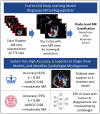Deep Learning for Echo Analysis, Tracking, and Evaluation of Mitral Regurgitation (DELINEATE-MR)
- PMID: 38881496
- PMCID: PMC11404755
- DOI: 10.1161/CIRCULATIONAHA.124.068996
Deep Learning for Echo Analysis, Tracking, and Evaluation of Mitral Regurgitation (DELINEATE-MR)
Abstract
Background: Artificial intelligence, particularly deep learning (DL), has immense potential to improve the interpretation of transthoracic echocardiography (TTE). Mitral regurgitation (MR) is the most common valvular heart disease and presents unique challenges for DL, including the integration of multiple video-level assessments into a final study-level classification.
Methods: A novel DL system was developed to intake complete TTEs, identify color MR Doppler videos, and determine MR severity on a 4-step ordinal scale (none/trace, mild, moderate, and severe) using the reading cardiologist as a reference standard. This DL system was tested in internal and external test sets with performance assessed by agreement with the reading cardiologist, weighted κ, and area under the receiver-operating characteristic curve for binary classification of both moderate or greater and severe MR. In addition to the primary 4-step model, a 6-step MR assessment model was studied with the addition of the intermediate MR classes of mild-moderate and moderate-severe with performance assessed by both exact agreement and ±1 step agreement with the clinical MR interpretation.
Results: A total of 61 689 TTEs were split into train (n=43 811), validation (n=8891), and internal test (n=8987) sets with an additional external test set of 8208 TTEs. The model had high performance in MR classification in internal (exact accuracy, 82%; κ=0.84; area under the receiver-operating characteristic curve, 0.98 for moderate or greater MR) and external test sets (exact accuracy, 79%; κ=0.80; area under the receiver-operating characteristic curve, 0.98 for moderate or greater MR). Most (63% internal and 66% external) misclassification disagreements were between none/trace and mild MR. MR classification accuracy was slightly higher using multiple TTE views (accuracy, 82%) than with only apical 4-chamber views (accuracy, 80%). In subset analyses, the model was accurate in the classification of both primary and secondary MR with slightly lower performance in cases of eccentric MR. In the analysis of the 6-step classification system, the exact accuracy was 80% and 76% with a ±1 step agreement of 99% and 98% in the internal and external test set, respectively.
Conclusions: This end-to-end DL system can intake entire echocardiogram studies to accurately classify MR severity and may be useful in helping clinicians refine MR assessments.
Keywords: artificial intelligence; deep learning; echocardiography; mitral valve insufficiency.
Conflict of interest statement
Dr Poterucha owns stock in Abbott Laboratories and Baxter International with research support provided to his institution from the Amyloidosis Foundation, American Heart Association (awards 933452 and 23SCISA1077494; https://doi.org/10.58275/AHA.23SCISA1077494.pc.gr.172160), Eidos Therapeutics, Pfizer, Edwards Lifesciences, and Janssen. Dr Hahn reports speaker fees from Abbott Structural, Baylis Medical, Edwards Lifesciences, Medtronic, Philips Healthcare, and Siemens Healthineers; she has institutional consulting contracts for which she receives no direct compensation with Abbott Structural, Anteris, Edwards Lifesciences, Medtronic and Novartis; she is chief scientific officer for the Echocardiography Core Laboratory at the Cardiovascular Research Foundation for multiple industry-sponsored valve trials, for which she receives no direct industry compensation. Dr Einstein reports receiving authorship fees from Wolters Kluwer Healthcare—UpToDate and serving on a scientific advisory board for Canon Medical Systems; his institution has grants/grants pending from Attralus, BridgeBio, Canon Medical Systems, GE HealthCare, Intellia Therapeutics, Ionis Pharmaceuticals, Neovasc, Pfizer, Roche Medical Systems, and W.L. Gore & Associates. The other authors report no conflicts.
Figures




Comment in
-
Artificial Intelligence and Mitral Regurgitation: Friend or Foe?Circulation. 2024 Sep 17;150(12):934-937. doi: 10.1161/CIRCULATIONAHA.124.070954. Epub 2024 Sep 16. Circulation. 2024. PMID: 39283937 No abstract available.
References
-
- Nkomo VT, Gardin JM, Skelton TN, Gottdiener JS, Scott CG, Enriquez-Sarano M. Burden of valvular heart diseases: a population-based study. Lancet. 2006;368:1005–1011. doi: 10.1016/S0140-6736(06)69208-8 - PubMed
-
- Coffey S, Roberts-Thomson R, Brown A, Carapetis J, Chen M, Enriquez-Sarano M, Zuhlke L, Prendergast BD. Global epidemiology of valvular heart disease. Nat Rev Cardiol. 2021;18:853–864. doi: 10.1038/s41569-021-00570-z - PubMed
-
- d’Arcy JL, Coffey S, Loudon MA, Kennedy A, Pearson-Stuttard J, Birks J, Frangou E, Farmer AJ, Mant D, Wilson J, et al. Large-scale community echocardiographic screening reveals a major burden of undiagnosed valvular heart disease in older people: the OxVALVE Population Cohort Study. Eur Heart J. 2016;37:3515–3522. doi: 10.1093/eurheartj/ehw229 - PMC - PubMed
-
- Parcha V, Patel N, Kalra R, Suri SS, Arora G, Arora P. Mortality due to mitral regurgitation among adults in the United States: 1999-2018. Mayo Clin Proc. 2020;95:2633–2643. doi: 10.1016/j.mayocp.2020.08.039 - PubMed
MeSH terms
Grants and funding
LinkOut - more resources
Full Text Sources

